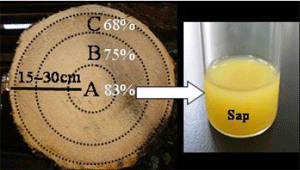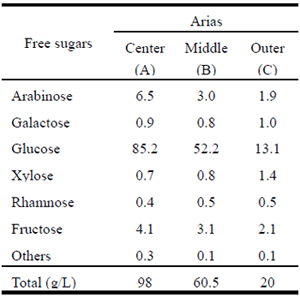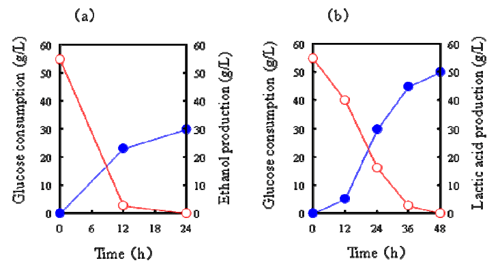Ethanol and Lactic Acid Production from Oil Palm Trunks
Description
According to the statistical data of the United States Department of Agriculture (USDA, 2005), palm oil, a major edible vegetable oil along with soybean oil, is produced at 3.5 million tons per year. Oil palm trees have an economic life span of approximately 20-25 years, after which old trees are felled and replanted. Although some portions of the old felled trunks are utilized for plywood manufacturing, almost all of them have no practical way of utilization and become troublesome wastes.
In an attempt to develop a method to utilize old oil palm trunks for fuel ethanol and usable materials production, we found that the felled oil palm trunk contains a large quantity of sap, which accounts for 75% to 80% of the whole trunk weight (Fig. 1), and abundant glucose and other fermentable sugars exist in the sap. Most especially, the amount of fermentable sugars is nearly 10% in the sap from the inner parts of the trunk (Table 1). Based on these findings, we tried to ferment the sap to produce ethanol using an industrial alcohol-producing strain, Saccharomyces cerevisiae Kyokai no. 7 (Fig 2a). Ethanol was produced from the sap at a comparable rate and yield to the reference fermentation, where glucose was used as a substrate. Likewise, we tried to produce lactic acid, a promising material for polylactate, from the sap using a lactic acid bacterium, Lactobacillus lactis (ATCC19435), and confirmed that sugars contained in the sap were readily converted to lactic acid with almost the same efficiency as the reference fermentation with glucose as a carbon source (Fig 2b). These results indicate that oil palm trunks are one of the most important resources for producing fuel ethanol and lactic acid in the Southeast Asian countries.
Figure, table
-
Fig. 1. Moisture contents and the sap from the felled oil palm trunk.
Cross-section of felled oil palm trunk: A, central parts; B, middle parts; C, outer parts, Percentage indicates moisture contents in each area of the trunk. The sap was squeezed from the central parts of the felled oil palm trunk. -
Table 1. Composition of free sugars in oil palm sap.
-
Fig. 2. Fermentation profiles of ethanol
(a) and lactic acid (b) productions using the sap from felled oil palm trunk, ○, glucose concentration; ●, productions of ethanol and lactic acid, respectively.
- Affiliation
-
Japan International Research Center for Agricultural Sciences Post-harvest Science and Technology Division
- Classification
-
Technical A
- Term of research
-
FY2007(FY2006~2011)
- Responsible researcher
-
KOSUGI Akihiko ( Post-harvest Science and Technology Division )
MURATA Yoshinori ( Post-harvest Science and Technology Division )
MORI Yutaka ( Post-harvest Science and Technology Division )
TANAKA Ryohei ( Forestry and Forest Products Research Institute )
MAGARA Kengo ( Forestry and Forest Products Research Institute )
- ほか
- Publication, etc.
-
Kosugi et al. Japanese Patent Application No. JP2007/74764 "Method for producing ethanol and lactic acid".
Mori et al. (2007) Annual Meeting of the Japan Institute of Energy. Fukuoka
Mori et al. (2007) The 4th Biomass-Asia Workshop.
- Japanese PDF
-
2007_seikajouhou_A4_ja_Part15.pdf498.15 KB



